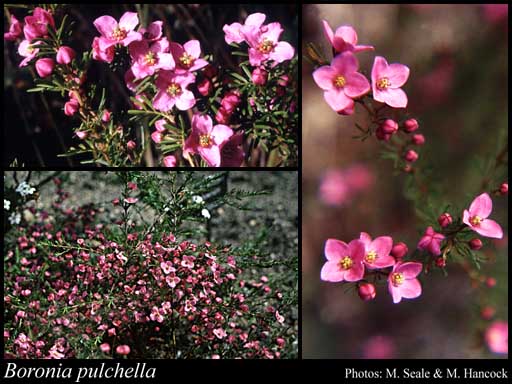- Reference
- Bull.Soc.Imp.Naturalistes Moscou 25 (2):162 (1852)
- Conservation Code
- Not threatened
- Naturalised Status
- Native to Western Australia
- Name Status
- Current
Shrub, (0.2-)0.5-1.2(-3) m high. Fl. pink, Sep to Nov. Stony & sandy soils. Rocky outcrops, gullies, along watercourses, hills.

Scientific Description
Shrub, spines absent; branchlets smooth, without distinct raised glands, +/- cylindrical in cross-section, covered in hairs or scales, the hairs stellate (star-shaped). Leaves opposite, compound, 9.5-20 mm long, with 5-9 leaflets, each 5-8 mm long, 0.8-1 mm wide, flat, the margins flat, smooth, without distinct raised glands, covered in hairs or scales, with stellate (star shaped) hairs; stipular excrescences absent. Flowers axillary, solitary; pedicels 5-6 mm long; calyx present, 2.5-4 mm long, smooth, without distinct raised glands, glabrous except for a ciliate marginal fringe, the hairs stellate (star-shaped); corolla pink, petals four, 8-11 mm long, imbricate (overlapping), free, glabrous; stamens twice as many as petals, 1.5-2 mm long, smooth, ciliate (with a marginal fringe of hairs); anthers 1-1.2 mm long, with an appendage; style 3 mm long, hairy. Flowers in September, October and November. Occurs in the South-West Botanical Province, in the Esperance IBRA region(s).
Distribution
- IBRA Regions
- Esperance Plains.
- IBRA Subregions
- Fitzgerald.
- Local Government Areas (LGAs)
- Albany, Cranbrook, Gnowangerup, Plantagenet.